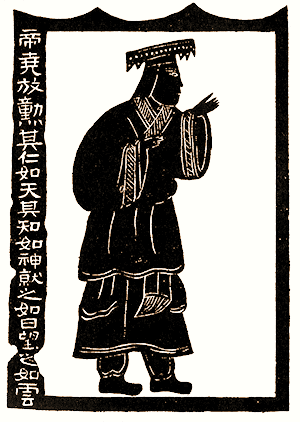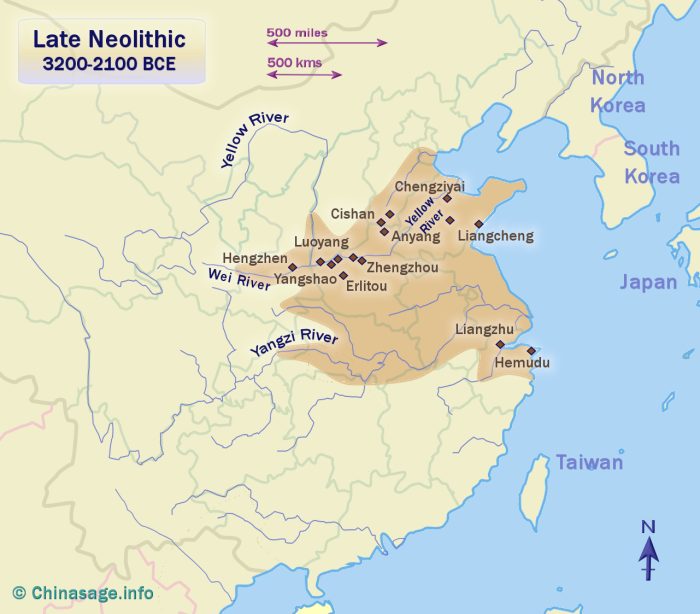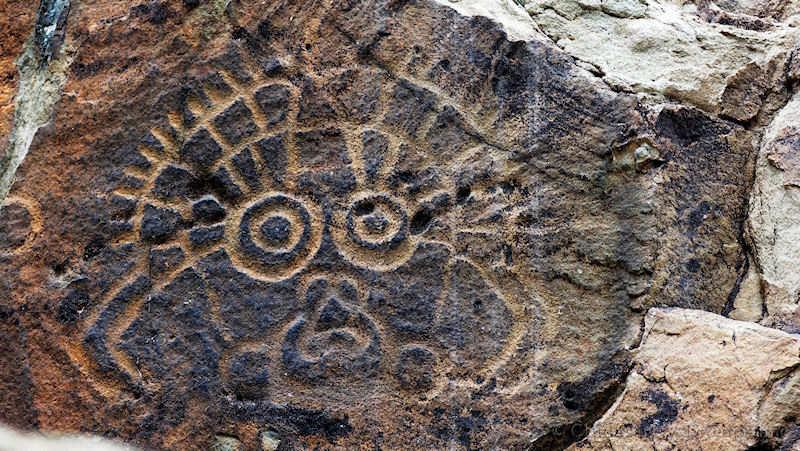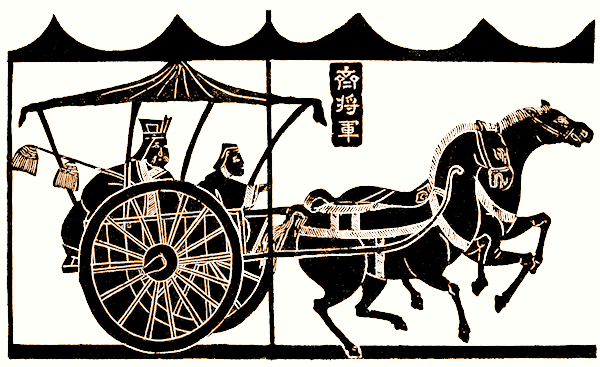The early history of China up to 1100BCE

China is immensely and justifiably proud of its long history. A continuous Chinese culture has been in existence since earliest times; it is the only civilization that can make such a claim. Many European archaeologists have sought to trace early Chinese civilization back to a common origin with that of the Babylonians and Egyptians. Their search has failed and so Chinese culture is believed to have sprung up entirely independently close to the Yellow River.

Archeology
Archeological discoveries (for example early human finds at Yuanmou in Yunnan) take the story of human habitation in China back as far as 1.7 million years. The uncovering of Peking WG Man (Homo erectus) at Zhoukoudian near Beijing affirms human habitation 0.5 million years ago. When it was found in 1920s this was taken as the early progenitor of all the Chinese people; however, further studies have shown that like all other modern humans they are descended from Homo sapiens in Africa. Finds at Banpo village near Xian have identified a Yangshao culture ➚ at 4,500BCE which was followed by the 3,000BCE Longshan culture ➚. The Yangshao villages used stone tools and fished with bone hooks along the Yellow river valley. They left behind distinctive pottery using, for some of it, a potter's wheel. The weaving of cloth had also started. The worship of the deities Fuxi and Nuwa began. The upper reaches of the Yellow River, fed by melting ice, are less prone to flooding than downstream. Here the Yellow River provides a dependable source of water to irrigate the fertile loess soil which is easy to work with antler and stone tools; making the location ideal for early agriculture. As in the Nile river valley, reliable annual crops led humans to settle and form fixed communities rather than live as wandering bands of hunter-gatherers. The whole country at this time was dominated by vast forests with elephants, tigers and rhinoceroses roaming the woods. By 5,500 years ago the Hongshan culture in Liaoning had already begun to produce fine ornaments made from jade.
In other areas of China, other cultures developed independently with very different traditions. For example the Sanxingdui culture ➚ (2800-800BCE) in Sichuan produced distinctive bronze heads. Cultivation of rice began as early as 7,000 years ago in the lower Yangzi River valley quite separate to the north.

Events
2718BCE Yellow Emperor born2696BCE Yellow Emperor became ruler
2598BCE Yellow Emperor no longer ruler
2333BCE Emperor Yao born
2294BCE Emperor Shun born
2123BCE Emperor Yu the Great born
1600BCE Shang dynasty began
1046BCE Shang dynasty ended
Legendary era to 2100BCE
During this time the Chinese system of writing evolved from a few simple pictorial characters to the rich script of the Qin Dynasty. Although accurately kept historical records push back China's documented past a long way, there is a point when fact and legend inter-mingle. In the case of Britain the 'legendary' era survives as recently as King Arthur in the 5th century CE, whereas in China you need to go back a further 2,500 years to the time of the Yellow Emperor ➚ c. 3000BCE , the founding father of China. There is a traditional continuous line of all the Kings and Emperors of China going all the way back to him. For more on the deities and legendary rulers of china please see our section on the Three Sovereigns and Five Sage Emperors.
Northern China produced pottery; silk and worked with jade (for the manufacture of weapons and ceremonial vessels). However, it is inaccurate to consider China as a unified ‘empire’ or ‘nation’ at this time, there were a number of independent kingdoms with little interaction between them; the traditional historical record gives a false sense of unity. China had a range of distinct cultures and languages within its modern boundaries at this time. To begin with there were thousands of independent village settlements with no central control; it was only around 2,000BCE that walled town communities like Shimao ➚, Shaanxi were built. These proto-cities controlled and protected the surrounding village communities.

Xia Dynasty 2100-1600BCE
Yu the Great's reign, which marked the start of the Xia dynasty, began the recorded history of China. Yu's first task was to repair the kingdom after a great flood, which some have connected with the Biblical flood of Noah. Emperor Yu is most remembered for his work on flood prevention along the Yellow River. Archeological research has found a number of autonomous communities each developing their own culture and traditions along the Yellow, Wei and Yangzi valleys, rather than a unified nation state. A city has been excavated at Taosi, Shanxi ➚ which shows impressive walls and perhaps the earliest sky observatory in the world. Some of the individual historical events during the Xia (for example floods and battles) recorded in the ancient texts have been confirmed by archeology.
At this early stage, long before iron and bronze were available, civilization revolved around simple agriculture close to the Yellow and Wei Rivers (in modern day Shanxi, Henan provinces). Yu the Great, the founder of the dynasty, is the main legendary figure from this period. He is believed to have divided the country into nine regions delineated by rivers giving China a traditional name ‘nine regions’ (九洲 jiǔ zhōu). More importantly he built flood defenses on the Yellow River. Rather than just building banks and levees he chose to build canals and sluices to redirect the water. Handicrafts such as silk weaving grew in importance. The first cities with tamped earth walls were built. One fragment of a 岁 suì or farmer's calendar has been dated to this period. During the Xia dynasty the Chinese script was further refined and used extensively for record keeping. It would seem ancestor veneration had already become well established. A lack of archeological dating evidence has made the confirmation of details of the Xia dynasty very difficult. Discoveries in 2016 ➚ at Lajia have given a tantalizing suggestion of a great flood at this time. This evidence suggests there was a real flood caused by a large landslip in Qinghai that blocked the Yellow River. All this was occurring at the same time as the Middle Kingdom ➚ of Egyptian pharaohs (c. 2000 to 1700BCE)

Shang Dynasty 商朝 1600-1100BCE
The tyrannical rule of the Emperor Jie of the Xia dynasty led to revolt and overthrow by Cheng Tang ➚ of Shang to found the Shang dynasty. Widespread developments began in economic, political and cultural spheres. The first walled cities were built at this time on a regular grid pattern layout. The capital was first Bo (near modern day Shangqiu) and then Yin (near modern day Anyang) both in Henan province. These cities seemed to have been mainly administrative and ritual centers; they also offered markets to the majority of people who were still engaged in agriculture. Shang China had a feudal economy where the landowners exercised absolute control over everyone in their fiefdom. The nobles lived a life of luxury while everyone else scratched a meager existence. Rule was passed solely through the male line, setting a precedent for subsequent dynasties. Warfare was revolutionized by the import of domesticated horses, making chariots the feared instrument of conquest. Although Shang rule was limited to the Yellow River valley its influence spread to the Yangzi river and along the south-eastern coast as far as Guangdong.

Development of the Chinese script continued, writing has survived on oracle bones and bronze vessels. About 1,000 characters of the 5,000 characters used in Shang times are still recognizably similar to those of today. The character for ‘shang’ 商 is found in modern day words relating to trade and business (for example 商务 shāng wù 'business, enterprise') suggesting that with the Shang came the first economic developments. The Chinese calendar system of leap months and ten day weeks was developed. In metalwork, they developed the ability to cast elaborate, massive bronze vessels ➚ which was unrivaled in the world at the time. Around 12,000 bronze vessels have survived to the present day. The tomb of Lady Hao ➚ is the only intact Shang tomb to survive to modern times; it shows the sophistication of the culture with a diverse range of ornate objects. Buried with their rulers were their many attendants.

Silk production grew in sophistication, although its fragility has meant that, although tools used to make it have survived, no fabric from this distant time remains. China's civilization expanded down the Yellow River to Anhui, Hunan, Shanxi, Hebei and Shandong. Growth was promoted by introducing water engineering for irrigation and flood control.
The great Han dynasty historian Sima Qian wrote an amazingly accurate history for this period. As with the Xia dynasty the end of the Shang came with the tyrannical and vicious rule of a ruler, in this case King Zhou (aka Zhou Xin). He led a profligate and debauched life and is noted for filling a lake with wine and devising cruel tortures for entertainment.
It was in the following Zhou dynasty founded by the founding fathers King Wen and Wu that China had developed a distinctive culture that had continued to the present day.